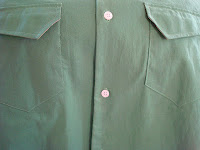Negroni 1 is finished so I got TMB to take some pictures of it (and me).
There's something weird going on with my right shoulder. I am supposing that this is to do with the mistake I made on that side of the collar.
The next pictures show off the contrasting under collar and the weirdness where the right shirt front, outer yoke and under collar meet
I would shorten the sleeves, maybe as much as two inches, if I made this shirt again and use real shirting because I think that it would improve the drape.
I think the back isn't bad but could benefit from a good pressing. Maybe the yoke is a shade wide for me? I think I will make more shirts in the future. I've enjoyed the challenge and the experience. I would like to try Negroni again and hopefully improve on this first effort. I think the first issues to address are my technical short comings and then look at fit.























































